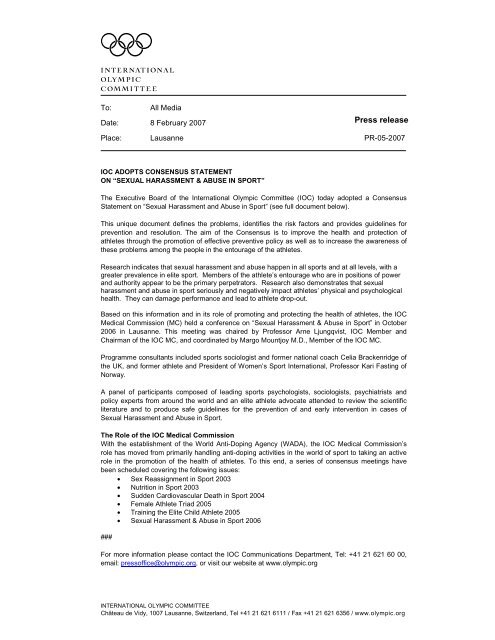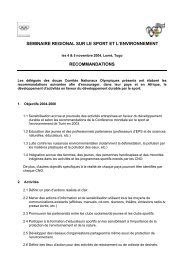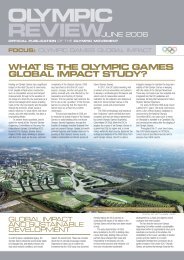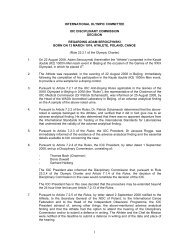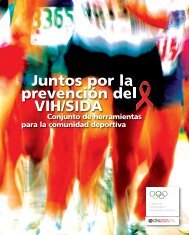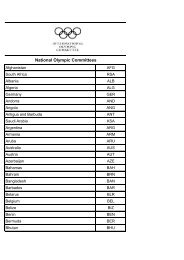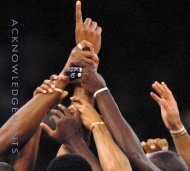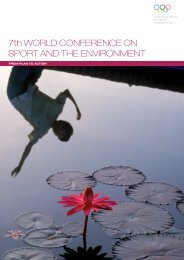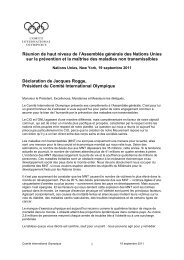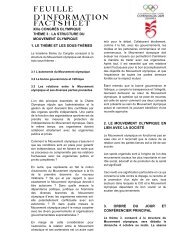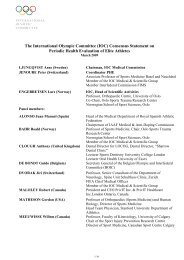Consensus Statement: Sexual harassment and abuse in sport
Consensus Statement: Sexual harassment and abuse in sport
Consensus Statement: Sexual harassment and abuse in sport
You also want an ePaper? Increase the reach of your titles
YUMPU automatically turns print PDFs into web optimized ePapers that Google loves.
To:<br />
All Media<br />
Date: 8 February 2007<br />
Press release<br />
Place: Lausanne PR-05-2007<br />
IOC ADOPTS CONSENSUS STATEMENT<br />
ON “SEXUAL HARASSMENT & ABUSE IN SPORT”<br />
The Executive Board of the International Olympic Committee (IOC) today adopted a <strong>Consensus</strong><br />
<strong>Statement</strong> on “<strong>Sexual</strong> Harassment <strong>and</strong> Abuse <strong>in</strong> Sport” (see full document below).<br />
This unique document def<strong>in</strong>es the problems, identifies the risk factors <strong>and</strong> provides guidel<strong>in</strong>es for<br />
prevention <strong>and</strong> resolution. The aim of the <strong>Consensus</strong> is to improve the health <strong>and</strong> protection of<br />
athletes through the promotion of effective preventive policy as well as to <strong>in</strong>crease the awareness of<br />
these problems among the people <strong>in</strong> the entourage of the athletes.<br />
Research <strong>in</strong>dicates that sexual <strong>harassment</strong> <strong>and</strong> <strong>abuse</strong> happen <strong>in</strong> all <strong>sport</strong>s <strong>and</strong> at all levels, with a<br />
greater prevalence <strong>in</strong> elite <strong>sport</strong>. Members of the athlete’s entourage who are <strong>in</strong> positions of power<br />
<strong>and</strong> authority appear to be the primary perpetrators. Research also demonstrates that sexual<br />
<strong>harassment</strong> <strong>and</strong> <strong>abuse</strong> <strong>in</strong> <strong>sport</strong> seriously <strong>and</strong> negatively impact athletes’ physical <strong>and</strong> psychological<br />
health. They can damage performance <strong>and</strong> lead to athlete drop-out.<br />
Based on this <strong>in</strong>formation <strong>and</strong> <strong>in</strong> its role of promot<strong>in</strong>g <strong>and</strong> protect<strong>in</strong>g the health of athletes, the IOC<br />
Medical Commission (MC) held a conference on “<strong>Sexual</strong> Harassment & Abuse <strong>in</strong> Sport” <strong>in</strong> October<br />
2006 <strong>in</strong> Lausanne. This meet<strong>in</strong>g was chaired by Professor Arne Ljungqvist, IOC Member <strong>and</strong><br />
Chairman of the IOC MC, <strong>and</strong> coord<strong>in</strong>ated by Margo Mountjoy M.D., Member of the IOC MC.<br />
Programme consultants <strong>in</strong>cluded <strong>sport</strong>s sociologist <strong>and</strong> former national coach Celia Brackenridge of<br />
the UK, <strong>and</strong> former athlete <strong>and</strong> President of Women’s Sport International, Professor Kari Fast<strong>in</strong>g of<br />
Norway.<br />
A panel of participants composed of lead<strong>in</strong>g <strong>sport</strong>s psychologists, sociologists, psychiatrists <strong>and</strong><br />
policy experts from around the world <strong>and</strong> an elite athlete advocate attended to review the scientific<br />
literature <strong>and</strong> to produce safe guidel<strong>in</strong>es for the prevention of <strong>and</strong> early <strong>in</strong>tervention <strong>in</strong> cases of<br />
<strong>Sexual</strong> Harassment <strong>and</strong> Abuse <strong>in</strong> Sport.<br />
The Role of the IOC Medical Commission<br />
With the establishment of the World Anti-Dop<strong>in</strong>g Agency (WADA), the IOC Medical Commission’s<br />
role has moved from primarily h<strong>and</strong>l<strong>in</strong>g anti-dop<strong>in</strong>g activities <strong>in</strong> the world of <strong>sport</strong> to tak<strong>in</strong>g an active<br />
role <strong>in</strong> the promotion of the health of athletes. To this end, a series of consensus meet<strong>in</strong>gs have<br />
been scheduled cover<strong>in</strong>g the follow<strong>in</strong>g issues:<br />
• Sex Reassignment <strong>in</strong> Sport 2003<br />
• Nutrition <strong>in</strong> Sport 2003<br />
• Sudden Cardiovascular Death <strong>in</strong> Sport 2004<br />
• Female Athlete Triad 2005<br />
• Tra<strong>in</strong><strong>in</strong>g the Elite Child Athlete 2005<br />
• <strong>Sexual</strong> Harassment & Abuse <strong>in</strong> Sport 2006<br />
###<br />
For more <strong>in</strong>formation please contact the IOC Communications Department, Tel: +41 21 621 60 00,<br />
email: pressoffice@olympic.org, or visit our website at www.olympic.org<br />
INTERNATIONAL OLYMPIC COMMITTEE<br />
Château de Vidy, 1007 Lausanne, Switzerl<strong>and</strong>, Tel +41 21 621 6111 / Fax +41 21 621 6356 / www.olympic.org
<strong>Consensus</strong> <strong>Statement</strong><br />
SEXUAL HARASSMENT AND ABUSE IN SPORT<br />
IOC Medical Commission Expert Panel<br />
Panel Members:<br />
Arne Ljungqvist (Sweden)<br />
Margo Mountjoy (Canada)<br />
Celia Brackenridge (UK)<br />
Kari Fast<strong>in</strong>g (Norway)<br />
Chairman, IOC Medical Commission<br />
<strong>Consensus</strong> <strong>Statement</strong> Coord<strong>in</strong>ator, IOC Medical Commission<br />
Program Consultant:<br />
Professor of Sport Sciences (Youth Sport), School of Sport <strong>and</strong><br />
Education, Brunel University<br />
Program Consultant:<br />
Professor at the Department of Social <strong>and</strong> Cultural Studies,<br />
Norwegian School of Sport Sciences<br />
Participants:<br />
Steven Boocock (UK) Child Protection <strong>in</strong> Sport Unit Director, National Society for the<br />
Prevention of Cruelty to Children<br />
Charlotte Bradley-Reus (Mex) President of NGO “DEMUSA”, Journalist, Researcher<br />
Joy Br<strong>in</strong>ger ((Wales)<br />
Senior Sports Psychologist to the Sports Council for Wales<br />
Paulo David (Switzerl<strong>and</strong>) UN Human Rights official, Human Rights <strong>in</strong> Youth Sport<br />
Margery Holman (Canada) Professor <strong>in</strong> the Department of K<strong>in</strong>esiology at University of<br />
W<strong>in</strong>dsor<br />
Sheldon Kennedy (Canada) Former NHL Hockey player, Founder of “Respect <strong>in</strong> Sport”<br />
Kimie Kumayasu (Japan) Associate Professor <strong>and</strong> Collaborative Researcher at Women's<br />
Studies Center <strong>in</strong> Osaka Prefecture University, Faculty of Liberal<br />
Arts <strong>and</strong> Sciences<br />
Secretary General of the Japan Society for Sport <strong>and</strong> Gender<br />
Studies<br />
S<strong>and</strong>ra Kirby (Canada) Olympian Chair <strong>and</strong> Professor of Sport Sciences, Department of<br />
Sociology, University of W<strong>in</strong>nipeg<br />
Trisha Leahy (Hong Kong) Head, Athlete <strong>and</strong> Scientific Services, Hong Kong Sports Institute<br />
Petra Moget (Netherl<strong>and</strong>s) Senior Advisor to Dutch Olympic Committee on <strong>Sexual</strong><br />
Harassment & Abuse, Human movement scientist <strong>and</strong> Senior<br />
advisor elite <strong>sport</strong><br />
Debbie Simms (Australia) Manager, Sport Ethics, Australian Sports Commission (advocate,<br />
policy <strong>and</strong> procedures expert)<br />
Jan Toftegaard-Stoeckel (Den) Ph.d. <strong>and</strong> assistant professor at University of Southern Denmark<br />
Institute of <strong>sport</strong> & Biomechanics<br />
Ian Tofler (USA)<br />
Sports Psychiatrist; Cl<strong>in</strong>ical Specialist & Researcher<br />
Maarten Weber (Netherl<strong>and</strong>s) Police Psychologist, Chief <strong>in</strong>spector of Police, Advisor to Dutch<br />
Olympic Committee on <strong>Sexual</strong> Harassment & Abuse
<strong>Consensus</strong> <strong>Statement</strong><br />
SEXUAL HARASSMENT AND ABUSE IN SPORT<br />
In its role of promot<strong>in</strong>g <strong>and</strong> protect<strong>in</strong>g the health of the athlete, the IOC Medical Commission<br />
recognises all the rights of athletes, <strong>in</strong>clud<strong>in</strong>g the right to enjoy a safe <strong>and</strong> supportive <strong>sport</strong><br />
environment. It is <strong>in</strong> such conditions that athletes are most likely to flourish <strong>and</strong> optimise their<br />
<strong>sport</strong><strong>in</strong>g performance. <strong>Sexual</strong> <strong>harassment</strong> <strong>and</strong> <strong>abuse</strong> are violations of human rights, regardless<br />
of cultural sett<strong>in</strong>g, that damage both <strong>in</strong>dividual <strong>and</strong> organisational health. While it is well known<br />
that <strong>sport</strong> offers significant potential for personal <strong>and</strong> social benefits, this potential is underm<strong>in</strong>ed<br />
where such problems occur. <strong>Sexual</strong> <strong>harassment</strong> <strong>and</strong> <strong>abuse</strong> occur worldwide. In <strong>sport</strong>, they give<br />
rise to suffer<strong>in</strong>g for athletes <strong>and</strong> others, <strong>and</strong> to legal, f<strong>in</strong>ancial <strong>and</strong> moral liabilities for <strong>sport</strong><br />
organisations. No <strong>sport</strong> is immune to these problems which occur at every performance level.<br />
Everyone <strong>in</strong> <strong>sport</strong> shares the responsibility to identify <strong>and</strong> prevent sexual <strong>harassment</strong> <strong>and</strong> <strong>abuse</strong><br />
<strong>and</strong> to develop a culture of dignity, respect <strong>and</strong> safety <strong>in</strong> <strong>sport</strong>. Sport organisations, <strong>in</strong> particular,<br />
are gatekeepers to safety <strong>and</strong> should demonstrate strong leadership <strong>in</strong> identify<strong>in</strong>g <strong>and</strong> eradicat<strong>in</strong>g<br />
these practices. A healthy <strong>sport</strong> system that empowers athletes can contribute to the prevention<br />
of sexual <strong>harassment</strong> <strong>and</strong> <strong>abuse</strong> <strong>in</strong>side <strong>and</strong> outside <strong>sport</strong>.<br />
This document summarises current scientific knowledge about the different forms of sexual<br />
<strong>harassment</strong> <strong>and</strong> <strong>abuse</strong>, the risk factors that might alert the <strong>sport</strong> community to early <strong>in</strong>tervention<br />
<strong>and</strong> the myths that deflect attention from these problems. It also proposes a set of<br />
recommendations for awareness rais<strong>in</strong>g, policy development <strong>and</strong> implementation, education <strong>and</strong><br />
prevention, <strong>and</strong> enhancement of good practice.<br />
DEFINING THE PROBLEM<br />
<strong>Sexual</strong> <strong>harassment</strong> <strong>and</strong> <strong>abuse</strong> <strong>in</strong> <strong>sport</strong> stem from power relations <strong>and</strong> <strong>abuse</strong>s of power. <strong>Sexual</strong><br />
<strong>harassment</strong> refers to behaviour towards an <strong>in</strong>dividual or group that <strong>in</strong>volves sexualised verbal,<br />
non-verbal or physical behaviour, whether <strong>in</strong>tended or un<strong>in</strong>tended, legal or illegal, that is based<br />
upon an <strong>abuse</strong> of power <strong>and</strong> trust <strong>and</strong> that is considered by the victim or a byst<strong>and</strong>er to be<br />
unwanted or coerced. <strong>Sexual</strong> <strong>abuse</strong> <strong>in</strong>volves any sexual activity where consent is not or cannot<br />
be given. In <strong>sport</strong>, it often <strong>in</strong>volves manipulation <strong>and</strong> entrapment of the athlete. <strong>Sexual</strong><br />
<strong>harassment</strong> <strong>and</strong> <strong>abuse</strong> occur with<strong>in</strong> an organisational culture that facilitates such opportunities.<br />
Indeed, they are symptoms of failed leadership <strong>in</strong> <strong>sport</strong>. Gender <strong>harassment</strong>, haz<strong>in</strong>g <strong>and</strong><br />
homophobia are all aspects of the sexual <strong>harassment</strong> <strong>and</strong> <strong>abuse</strong> cont<strong>in</strong>uum <strong>in</strong> <strong>sport</strong> (see<br />
Appendix 1). Gender <strong>harassment</strong> consists of derogatory treatment of one gender or another<br />
which is systematic <strong>and</strong> repeated but not necessarily sexual. Haz<strong>in</strong>g <strong>in</strong>volves abusive <strong>in</strong>itiation<br />
rituals that often have sexual components <strong>and</strong> <strong>in</strong> which newcomers are targeted. Homophobia is<br />
a form of prejudice <strong>and</strong> discrim<strong>in</strong>ation rang<strong>in</strong>g from passive resentment to active victimisation of<br />
lesbian, gay, bisexual <strong>and</strong> transgendered people.<br />
SCIENTIFIC EVIDENCE: PREVALENCE, RISKS AND CONSEQUENCES<br />
Research <strong>in</strong>dicates that sexual <strong>harassment</strong> <strong>and</strong> <strong>abuse</strong> happen <strong>in</strong> all <strong>sport</strong>s <strong>and</strong> at all levels.<br />
Prevalence appears to be higher <strong>in</strong> elite <strong>sport</strong>. Members of the athlete’s entourage who are <strong>in</strong><br />
positions of power <strong>and</strong> authority appear to be the primary perpetrators. Peer athletes have also<br />
been identified as perpetrators. Males are more often reported as perpetrators than females.
Athletes are silenced by the sexual <strong>harassment</strong> <strong>and</strong> <strong>abuse</strong> process. The risk of sexual<br />
<strong>harassment</strong> <strong>and</strong> <strong>abuse</strong> is greater when there is a lack of protection, high perpetrator motivation<br />
<strong>and</strong> high athlete vulnerability (especially <strong>in</strong> relation to age <strong>and</strong> maturation). There is no evidence<br />
that the amount of cloth<strong>in</strong>g cover or the type of <strong>sport</strong> are risk factors: these are myths. Research<br />
identifies risk situations as the locker-room, the play<strong>in</strong>g field, trips away, the coach’s home or car,<br />
<strong>and</strong> social events, especially where alcohol is <strong>in</strong>volved. Team <strong>in</strong>itiations or end-of-season<br />
celebrations can also <strong>in</strong>volve sexually abusive behaviour aga<strong>in</strong>st <strong>in</strong>dividuals or groups.<br />
Research demonstrates that sexual <strong>harassment</strong> <strong>and</strong> <strong>abuse</strong> <strong>in</strong> <strong>sport</strong> seriously <strong>and</strong> negatively<br />
impact on athletes’ physical <strong>and</strong> psychological health. It can result <strong>in</strong> impaired performance <strong>and</strong><br />
lead to athlete drop-out. Cl<strong>in</strong>ical data <strong>in</strong>dicate that psychosomatic illnesses, anxiety, depression,<br />
substance <strong>abuse</strong>, self harm <strong>and</strong> suicide are some of the serious health consequences. Passive<br />
attitudes/non-<strong>in</strong>tervention, denial <strong>and</strong>/or silence by people <strong>in</strong> positions of power <strong>in</strong> <strong>sport</strong><br />
(particularly byst<strong>and</strong>ers) <strong>in</strong>creases the psychological harm of sexual <strong>harassment</strong> <strong>and</strong> <strong>abuse</strong>. Lack<br />
of byst<strong>and</strong>er action also creates the impression for victims that sexually harass<strong>in</strong>g <strong>and</strong> abusive<br />
behaviours are legally <strong>and</strong> socially acceptable <strong>and</strong>/or that those <strong>in</strong> <strong>sport</strong> are powerless to speak<br />
out aga<strong>in</strong>st it.<br />
RELATIONSHIPS IN SPORT<br />
<strong>Sexual</strong> <strong>harassment</strong> <strong>and</strong> <strong>abuse</strong> <strong>in</strong> <strong>sport</strong> do not discrim<strong>in</strong>ate on the basis of age, gender, race,<br />
sexual orientation or disability. Athletes come from many different cultural <strong>and</strong> family<br />
backgrounds <strong>and</strong> are the centre of a system of relationships focused on help<strong>in</strong>g them to achieve<br />
their <strong>sport</strong> potential. There is always a power difference <strong>in</strong> an athlete’s relationships with<br />
members of their entourage (coaches, scientific <strong>and</strong> medical staff, adm<strong>in</strong>istrators etc.). This<br />
power difference, if misused, can lead to sexual <strong>harassment</strong> <strong>and</strong> <strong>abuse</strong> <strong>and</strong>, <strong>in</strong> particular, to<br />
exploitative sexual relationships with athletes.<br />
These relationships require that a significant amount of time be spent together <strong>in</strong> the emotionally<br />
<strong>in</strong>tense environment of competitive <strong>sport</strong>. This situation has the potential to put the athlete at risk<br />
of isolation with<strong>in</strong> a controll<strong>in</strong>g relationship where his/her power <strong>and</strong> right to make decisions is<br />
underm<strong>in</strong>ed.<br />
All adults <strong>in</strong> an athlete’s environment must adopt clear guidel<strong>in</strong>es about their roles,<br />
responsibilities <strong>and</strong> appropriate relationship boundaries. It is essential that each member of the<br />
entourage, <strong>and</strong> any other authority figure, stays with<strong>in</strong> the boundaries of a professional<br />
relationship with the athlete.<br />
PREVENTION STRATEGIES<br />
Accepted prevention strategies <strong>in</strong>clude policies with associated codes of practice, education <strong>and</strong><br />
tra<strong>in</strong><strong>in</strong>g, compla<strong>in</strong>t <strong>and</strong> support mechanisms <strong>and</strong> monitor<strong>in</strong>g <strong>and</strong> evaluation systems. Regardless<br />
of cultural differences, every <strong>sport</strong> organisation should have these provisions <strong>in</strong> place.<br />
The policy is a statement of <strong>in</strong>tent that demonstrates a commitment to create a safe <strong>and</strong> mutually<br />
respectful environment. The policy should state what is required <strong>in</strong> relation to the promotion of<br />
rights, well-be<strong>in</strong>g <strong>and</strong> protection. It allows the organisation to generate prompt, impartial <strong>and</strong> fair<br />
action when a compla<strong>in</strong>t or allegation is made. It further allows it to take discipl<strong>in</strong>ary, penal <strong>and</strong><br />
other measures, as appropriate.
Codes of practice describe acceptable st<strong>and</strong>ards of behaviour that, when followed, serve to<br />
implement the policy. St<strong>and</strong>ards of behaviour set a clear benchmark for what is acceptable <strong>and</strong><br />
unacceptable. They can help to m<strong>in</strong>imise opportunities for sexual <strong>harassment</strong> <strong>and</strong> <strong>abuse</strong> <strong>and</strong><br />
unfounded allegations. (See Appendix 2.)<br />
RECOMMENDATIONS<br />
All <strong>sport</strong> organisations should:<br />
1. develop policies <strong>and</strong> procedures for the prevention of sexual <strong>harassment</strong> <strong>and</strong> <strong>abuse</strong>;<br />
2. monitor the implementation of these policies <strong>and</strong> procedures;<br />
3. evaluate the impact of these policies <strong>in</strong> identify<strong>in</strong>g <strong>and</strong> reduc<strong>in</strong>g sexual <strong>harassment</strong> <strong>and</strong><br />
<strong>abuse</strong>;<br />
4. develop an education <strong>and</strong> tra<strong>in</strong><strong>in</strong>g program on sexual <strong>harassment</strong> <strong>and</strong> <strong>abuse</strong> <strong>in</strong> their <strong>sport</strong>(s);<br />
5. promote <strong>and</strong> exemplify equitable, respectful <strong>and</strong> ethical leadership<br />
6. foster strong partnerships with parents/carers <strong>in</strong> the prevention of sexual <strong>harassment</strong> <strong>and</strong><br />
<strong>abuse</strong>; <strong>and</strong><br />
7. promote <strong>and</strong> support scientific research on these issues.<br />
Through sexual <strong>harassment</strong> <strong>and</strong> <strong>abuse</strong> prevention <strong>in</strong> <strong>sport</strong>, <strong>sport</strong> will become a safer, healthier<br />
<strong>and</strong> more positive environment for all.<br />
In case of divergence between the English version of the <strong>Consensus</strong> <strong>Statement</strong> <strong>and</strong> the<br />
translated versions, the English version prevails.
Appendix 1<br />
The sexual exploitation cont<strong>in</strong>uum<br />
Source: Adapted from Brackenridge (1997)<br />
SEX DISCRIMINATION<br />
SEXUAL & GENDER HARASSMENT<br />
HAZING & SEXUAL ABUSE<br />
I N S T I T U T I O N A L ..............................................................P E R S O N A L<br />
"the chilly climate” "unwanted attention" "groomed or coerced"<br />
vertical & horizontal job<br />
segregation<br />
lack of <strong>harassment</strong> policy<br />
<strong>and</strong>/or officer or report<strong>in</strong>g<br />
channels<br />
written or verbal <strong>abuse</strong> or threats<br />
sexually oriented comments jokes, lewd<br />
comments or sexual <strong>in</strong>nuendoes, taunts about<br />
body, dress, marital situation or sexuality<br />
exchange of reward or<br />
privilege for sexual<br />
favours<br />
grop<strong>in</strong>g<br />
lack of counsell<strong>in</strong>g or<br />
mentor<strong>in</strong>g systems<br />
differential pay or rewards or<br />
promotion prospects on the<br />
basis of sex<br />
ridicul<strong>in</strong>g of performance<br />
sexual or homophobic graffiti<br />
practical jokes based on sex<br />
<strong>in</strong>decent exposure<br />
forced sexual activity<br />
sexual assault<br />
poorly/unsafely designed or lit<br />
venues<br />
<strong>in</strong>timidat<strong>in</strong>g sexual remarks, propositions,<br />
<strong>in</strong>vitations or familiarity<br />
absence of basic security<br />
dom<strong>in</strong>ation of meet<strong>in</strong>gs, play<br />
space or equipment<br />
physical/sexual violence<br />
condescend<strong>in</strong>g or patronis<strong>in</strong>g behaviour<br />
underm<strong>in</strong><strong>in</strong>g self-respect or work performance<br />
rape<br />
physical contact, fondl<strong>in</strong>g, p<strong>in</strong>ch<strong>in</strong>g or kiss<strong>in</strong>g<br />
<strong>in</strong>cest<br />
v<strong>and</strong>alism on the basis of sex<br />
offensive phone calls or photos<br />
stalk<strong>in</strong>g<br />
bully<strong>in</strong>g based on sex
Appendix 2 Criteria for sexual <strong>harassment</strong> <strong>and</strong> <strong>abuse</strong> policies <strong>and</strong> codes<br />
of practice <strong>in</strong> a <strong>sport</strong> organisation<br />
The policy on sexual <strong>harassment</strong> <strong>and</strong> <strong>abuse</strong> should:<br />
• identify <strong>and</strong> address these issues<br />
• be clear <strong>and</strong> easily understood<br />
• <strong>in</strong>volve consultation with athletes<br />
• be widely communicated through publication <strong>and</strong> education<br />
• be approved by the relevant management body (e.g. Management Board or Executive<br />
Committee) <strong>and</strong> <strong>in</strong>corporated <strong>in</strong>to its constitution <strong>and</strong>/or regulations<br />
• apply to all <strong>in</strong>volved <strong>in</strong> the organisation<br />
• be supported by a comprehensive education <strong>and</strong> tra<strong>in</strong><strong>in</strong>g strategy<br />
• be reviewed <strong>and</strong> updated on a regular basis, particularly when there is a major change <strong>in</strong><br />
the constitutional regulations of the organisation or <strong>in</strong> the law.<br />
The policy should:<br />
• state that all members have a right to respect, safety <strong>and</strong> protection<br />
• state that the welfare of members is paramount<br />
• identify who has responsibility for implement<strong>in</strong>g <strong>and</strong> uphold<strong>in</strong>g it<br />
• specify what constitutes a violation<br />
• specify the range of consequences for such violations<br />
• specify procedures for report<strong>in</strong>g <strong>and</strong> h<strong>and</strong>l<strong>in</strong>g compla<strong>in</strong>ts<br />
• provide details of where to seek advice <strong>and</strong> support for all parties <strong>in</strong>volved <strong>in</strong> a compla<strong>in</strong>t<br />
• specify procedures for ma<strong>in</strong>ta<strong>in</strong><strong>in</strong>g records<br />
• provide guidance for third party report<strong>in</strong>g (‘whistleblow<strong>in</strong>g’).<br />
There should be codes of practice on sexual <strong>abuse</strong> <strong>and</strong> <strong>harassment</strong> for specific member roles <strong>in</strong><br />
a <strong>sport</strong> organisation. The code of practice on sexual <strong>harassment</strong> <strong>and</strong> <strong>abuse</strong> should:<br />
• provide guidance on appropriate/expected st<strong>and</strong>ards of behaviour from all members<br />
• set out clear processes for deal<strong>in</strong>g with unacceptable behaviours, <strong>in</strong>clud<strong>in</strong>g guidance on<br />
discipl<strong>in</strong>ary measures <strong>and</strong> sanctions.
Resources list – <strong>Sexual</strong> <strong>harassment</strong> <strong>and</strong> <strong>abuse</strong> <strong>in</strong> <strong>sport</strong><br />
This is not a def<strong>in</strong>itive list but merely <strong>in</strong>dicative of some of the basel<strong>in</strong>e sources on this subject.<br />
Australian Sports Commission (2006) Ethics <strong>in</strong> Sport – Member Protection. Available at<br />
www.au<strong>sport</strong>.gov.au/ethics/memprot.asp<br />
Brackenridge, C.H., Pitchford, A., Nutt, G. <strong>and</strong> Russell, K. (2007) Child Welfare <strong>in</strong> Football: An<br />
Exploration of Children’s Welfare <strong>in</strong> the Modern Game. London: Routledge/Taylor & Francis.<br />
Brackenridge, C.H. <strong>and</strong> Fast<strong>in</strong>g, K. (eds) (2002) <strong>Sexual</strong> Harassment <strong>and</strong> Abuse <strong>in</strong> Sport -<br />
International Research <strong>and</strong> Policy Perspectives. London: Whit<strong>in</strong>g <strong>and</strong> Birch.<br />
Brackenridge, C.H. (2001) Spoil<strong>sport</strong>s: Underst<strong>and</strong><strong>in</strong>g <strong>and</strong> Prevent<strong>in</strong>g <strong>Sexual</strong> Exploitation <strong>in</strong><br />
Sport. London: Routledge.<br />
David, P. (2005) Human Rights <strong>in</strong> Youth Sport: A Critical Review of Children’s Rights <strong>in</strong><br />
Competitive Sports. London: Routledge.<br />
Fast<strong>in</strong>g, K., Brackenridge, C. <strong>and</strong> Sundgot-Borgen, J. (2003) ‘Experiences of sexual <strong>harassment</strong><br />
<strong>and</strong> <strong>abuse</strong> among Norwegian elite female athletes <strong>and</strong> non-athletes’, Research Quarterly for<br />
Exercise <strong>and</strong> Sport 74(1):84-97.<br />
Johnson, J. <strong>and</strong> Holman, M. (eds) (2004) Mak<strong>in</strong>g the Team: Inside the world of <strong>sport</strong> <strong>in</strong>itiations<br />
<strong>and</strong> haz<strong>in</strong>g. Toronto: Canadian Scholar’s Press.<br />
Kirby, S. Greaves, L. <strong>and</strong> Hanvkivsky, O. (2000) The Dome of Silence: <strong>Sexual</strong> Harassment <strong>and</strong><br />
Abuse <strong>in</strong> Sport. Halifax. Nova Scotia: Fernwood Publish<strong>in</strong>g/London: Zed Books.<br />
Out Games (2006) Declaration of Montreal on Lesbian, Gay, Bisexual, <strong>and</strong> Transgender Human<br />
Rights. Described at http://en.wikipedia.org/wiki/Declaration_of_Montreal<br />
Panathlon International (2004) Declaration on Ethics <strong>in</strong> Youth Sport. Available at<br />
www.panathlon.net<br />
Sport Engl<strong>and</strong>/NSPCC Child Protection <strong>in</strong> Sport Unit (2003) National St<strong>and</strong>ards for Safeguard<strong>in</strong>g<br />
Children <strong>in</strong> Sport. Available at www.thecpsu.org.uk<br />
Tofler, I. <strong>and</strong> de Geronimo, T.F. (2000) Keep<strong>in</strong>g Your Kids Out Front Without Kick<strong>in</strong>g Them From<br />
Beh<strong>in</strong>d: How to Manage High-achiev<strong>in</strong>g Athletes, Scholars <strong>and</strong> Perform<strong>in</strong>g Artists. San Fransico,<br />
CA: Jossey-Bass.<br />
WomenSport International Position <strong>Statement</strong> on <strong>Sexual</strong> Harassment <strong>in</strong> Sport. Available at<br />
www.women<strong>sport</strong><strong>in</strong>ternational.org<br />
C Brackenridge <strong>and</strong> K Fast<strong>in</strong>g<br />
12 11 06


